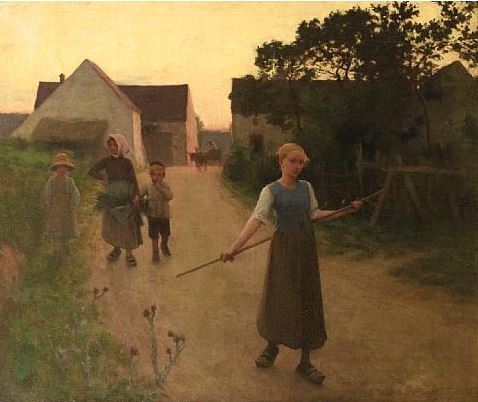Étienne Azambre on:
[Wikipedia]
[Google]
[Amazon]

 Étienne Azambre (2 February 1859, Paris -21 June 1933, Paris) was a French painter, best known for his religious and genre scenes, done in a subdued manner.
Étienne Azambre (2 February 1859, Paris -21 June 1933, Paris) was a French painter, best known for his religious and genre scenes, done in a subdued manner.
More works by Azambre
@ ArtNet
"Étienne Azambre, le peintre des Anges"
a website by Franz Torres-Quevedo {{DEFAULTSORT:Azambre, Etienne 1859 births 1933 deaths 19th-century French painters Religious painters French genre painters Painters from Paris 20th-century French painters

 Étienne Azambre (2 February 1859, Paris -21 June 1933, Paris) was a French painter, best known for his religious and genre scenes, done in a subdued manner.
Étienne Azambre (2 February 1859, Paris -21 June 1933, Paris) was a French painter, best known for his religious and genre scenes, done in a subdued manner.
Life & work
His father was a lawyer. After attending theCollège Stanislas de Paris
The Collège Stanislas de Paris (), colloquially known as Stan, is a highly selective private Catholic school in Paris, situated on " Rue Notre-Dame-des-Champs" in the 6th arrondissement. It has more than 3,000 students, from preschool to '' clas ...
, he decided to become an artist. From 1879 to 1882, he was enrolled at the Académie Julian
The Académie Julian () was a private art school for painting and sculpture founded in Paris, France, in 1867 by French painter and teacher Rodolphe Julian (1839–1907) that was active from 1868 through 1968. It remained famous for the number a ...
, then attended the École Nationale des Beaux-Arts
École may refer to:
* an elementary school in the French educational stages normally followed by secondary education establishments (collège and lycée)
* École (river), a tributary of the Seine flowing in région Île-de-France
* École, Savo ...
until 1885, where he studied with William Bouguereau
William-Adolphe Bouguereau (; 30 November 1825 – 19 August 1905) was a French academic painter. In his realistic genre paintings, he used mythological themes, making modern interpretations of classical subjects, with an emphasis on the female ...
and Tony Robert-Fleury. During his military duty in Orléans, he made lifelong friends with the painters Lucien Simon and Georges Desvallières.
Between 1883 and 1904, he exhibited regularly at the Salon des Artistes français In 1889, he participated in the annual exhibition held by the Friends of Art of the Département of Seine-et-Oise, which was held at the Château de Versailles. In 1893, he had a showing at the .
His religious works could also be seen at several artistic exhibitions organized by the Rosicrucians
Rosicrucianism is a spiritual and cultural movement that arose in Europe in the early 17th century after the publication of several texts purported to announce the existence of a hitherto unknown esoteric order to the world and made seeking its ...
. Their largest was held in 1893, at the , which was demolished in 1988. Many of his works were reproduced as illustrations in magazines such as '' Le Monde Illustré'', ''La Famille'' and ''La France Illustrée''.
In 1895, he was one of the artists chosen to decorate the Church of Sainte Marie-Madeleine of Équennes-Éramecourt
Équennes-Éramecourt (; Picard: ''Étcheinne-Érinmecourt'') is a commune in the Somme department in Hauts-de-France in northern France.
Geography
Formed from the administrative merger of the two villages of Équennes and Éramecourt in 1973 ...
in Somme __NOTOC__
Somme or The Somme may refer to: Places
*Somme (department), a department of France
*Somme, Queensland, Australia
*Canal de la Somme, a canal in France
*Somme (river), a river in France
Arts, entertainment, and media
* ''Somme'' (book), a ...
. He created fresco
Fresco (plural ''frescos'' or ''frescoes'') is a technique of mural painting executed upon freshly laid ("wet") lime plaster. Water is used as the vehicle for the dry-powder pigment to merge with the plaster, and with the setting of the plaste ...
es that adorn the cupola, representing the Coronation of the Virgin
The Coronation of the Virgin or Coronation of Mary is a subject in Christian art, especially popular in Italy in the 13th to 15th centuries, but continuing in popularity until the 18th century and beyond. Christ, sometimes accompanied by God th ...
in the presence of a large assembly of angels. Later, he became a member of the , where he participated in their exhibitions, held the office of Vice-President for a short time and contributed numerous articles to their magazine, ''Notes d'Art et d'Archéologie''. This helped him establish a relationship with the publisher, , which specialized in religious items. He eventually provided hundreds of pious images, many for postcards, reproduced by lithography, rotogravure and chromolithography. He focused entirely on scenes from the New Testament.
Between 1916 and 1919, he devoted himself almost exclusively to producing four large frescoes, representing the Nativity and the Assumption, at the in Yonne, a village near his family estate. Following his death, in 1933, he was interred in a nearby cemetery.
References
Further reading
* Enzo Pagliara, ''Étienne Azambre: un pittore per la religione : immaginette d'autore tra Otto e Novecento'', Barbieri, 2003External links
More works by Azambre
@ ArtNet
"Étienne Azambre, le peintre des Anges"
a website by Franz Torres-Quevedo {{DEFAULTSORT:Azambre, Etienne 1859 births 1933 deaths 19th-century French painters Religious painters French genre painters Painters from Paris 20th-century French painters